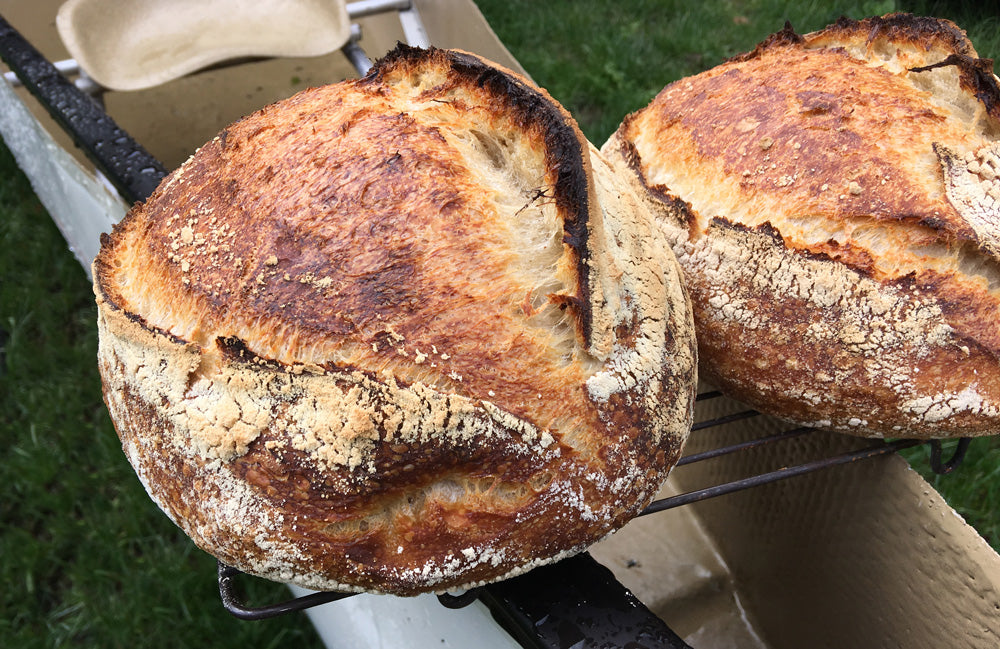March is Flour Month and we are celebrating, here at Hummingbird. Over the past 3 years or so, I've personally learned a lot about flour. Most of my education did not come from sitting in class, reading, or watching videos online. It was hands-on learning about sourdough bread-making, baking and maintaining the starter that bestowed the knowledge I've gained. If you, like so many, took up Sourdough Bread during the pandemic, then you probably learned a lot too. Here are the five concepts that hit me as I was trying, failing, and eventually succeeding in my quest to master Sourdough.
Basics of Yeast (Naturally Leavening)
Natural yeast in the air is everywhere. It is amazing to be able to cultivate it in a matter of a few days to a week and be able to establish a vibrant natural leavening that will make beautifully risen loaves. More incredible is that some people have maintained their starter for years, decades, even centuries. I've learned that it is incredibly resilient and forgiving. Temperature is the most critical element, besides time, water and flour. When you can control temperature or time (or both), you can be quite successful. I would encourage anyone wanting to learn to make sourdough bread to simply start. The process to establish a new starter is well documented and you can see the steps in this video.
Maintaining the Starter
An active sourdough starter is always working at room temperatures. The refrigerator will slow the activity to a stand still and is the best way to keep your starter if you aren't baking very often or when you will not be around for more than a couple of days to "feed" your starter. Using various flours to maintain the starter can boost a more lively rise. Rye flour is known to help grow the yeast levels and therefore the rise potential. The process can be very meditative in its simplicity and wonder. The trials and challenges are very satisfying to learn from. I find the act of feeding and watching it poetic and grounding - peaceful. Naming your starter is part of the fun!
Knead - No Need
When I first made bread years and years ago, I believed that kneading was the critical action to form elasticity and looked for the 'window pane' which would ensure a consistent airy crumb. Now, my understanding has changed considerably. I've tried all the techniques from No-Knead (mixing only) to the Slap and Fold. I now believe that time is the secret and not the kneading. The hydration of the flour (absorbing the water) takes time. In a matter of 15-45 minutes most dough will become fully hydrated and the kneading is not that important, but the folding does help to create structure, uniformity and improves the aesthetic of the rising dough. I encourage you to experiment.
Flour Protein (Gluten), or Which Flour to Use
First, I do not consider myself a scientist, but more of an artist. I understand the protein content in flour is largely correlated to gluten content. Bread flour is the highest in protein at 11-15% or higher. Cake flour is the lowest at 5-8%, and pastry flour is 8-10%. All-Purpose flour is in the middle with 10-12% protein. The higher the protein the chewier and more elastic the texture. I've learned that "chewier" can be experienced as tough, and though the higher protein can produce beautiful hearty breads that taste amazing, sometimes a softer, more tender bread is what I'm looking for. As a pizza maker, I have tried combining flours to discover a chewy, yet tender crust that is crispy too. There are many flours made from ancient grains that make incredibly good bread. I encourage you to try and taste them all.
Baking Environment
The baking temperature and the ability to capture the steam (or inject steam) is the final important factor in baking beautiful bread. After trying for years to add steam to my various home ovens with only moderate success, I read about baking with a Dutch oven. The Dutch oven or combo cooker, with the lid sealing the baking space, captures the moisture from the rising loaf and enables the surface of the dough to stretch and grow instead of getting hard too early and just erupting from the weakest area. This was transformational. I believe that moisture in the baking environment is the key to good "oven spring". I really saw this when baking rustic sourdough loaves, but the basic idea extends to almost all bread baking. The dry heat tends to quickly bake the dough on the surface stopping its ability to expand. I've found the Dutch oven to be indispensable.
For me, my experience is the fun. Trying new things and new techniques is what makes bread baking with natural leavening so satisfying. If you haven't tried baking your own sourdough bread, I suggest going to The Perfect Loaf and follow the instructions for the Beginner's Sourdough Bread. This has been my favorite place for reference. I hope you have enjoyed my insights and, more importantly, I hope you get creative and active in the kitchen making all kinds of breads!
Written by Paul Adkins, Marketing and Brand Coordinator at Hummingbird Wholesale. With a passion for baking, especially pizza, Paul took his love to the next level when he set out to develop the basis (the dough) for the Wheel Apizza Pub's naturally leavened pizza as it got rolling. He also taught Sourdough Basics at the Fun with Fermentation Festival in 2017 and the Sourdough Sessions (staff education) in 2021 at Hummingbird.

